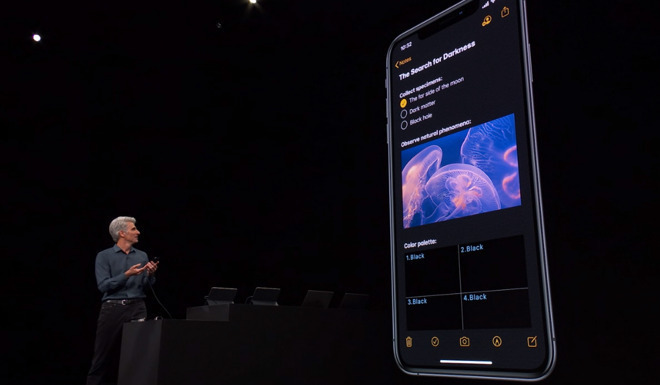Fifth public beta of iOS 13, iPadOS 13, tvOS 13 now available
A day after the most recent developer beta of tvOS 13, iOS 13, and iPadOS 13, Apple has made the same build available for public beta testers.

iOS 13's 'Dark Mode'
Participants of Apple's public beta program can download the latest versions to their devices as an over-the-air update, via Settings > General > Software Update. Members of the public interested in trying out the next-generation operating systems can sign up for the program by the official website.
This new batch of releases is functionally similar to the developer beta versions, which saw the fourth builds of both iOS 13 and iPadOS 13 provided for testing on Wednesday.
Both AppleInsider and Apple itself strongly recommend users don't install the betas on to "mission-critical" or primary devices, as there is the remote possibility of data loss or other issues. Instead, testers should install betas onto secondary or non-essential devices, and to make sure there are sufficient backups of important data before updating.

iOS 13's 'Dark Mode'
Participants of Apple's public beta program can download the latest versions to their devices as an over-the-air update, via Settings > General > Software Update. Members of the public interested in trying out the next-generation operating systems can sign up for the program by the official website.
This new batch of releases is functionally similar to the developer beta versions, which saw the fourth builds of both iOS 13 and iPadOS 13 provided for testing on Wednesday.
Both AppleInsider and Apple itself strongly recommend users don't install the betas on to "mission-critical" or primary devices, as there is the remote possibility of data loss or other issues. Instead, testers should install betas onto secondary or non-essential devices, and to make sure there are sufficient backups of important data before updating.


Comments
Long-term, this work should result in future OS-level work being vanishingly unlikely to cause user data loss. The goal is for the OS volume to be read-only. This allows things like staged upgrades and rollback, where you build a whole new OS volume on the drive and point the system to that. If things don't work properly, you point the system back to the previous OS volume, and everything is back to the way it was on that version.
I have been running the iPad OS Beta from the first and it is pretty solid. Little things but nothing too worrisome.
Same here, tried all week on MBP 13" 2017 (2 Thunderbolt).
Apple's storage subsystem has three major concepts to understand:
A Physical Store is a physical device. A hard drive, an SSD, whatever. This is what actually records the data. Redundancy can be implemented at this level using AppleRAID.
A Container is an aggregate of one or more Physical Stores. This is where the data tiering for a Fusion Drive happens.
Finally, a Volume is like a partition, and it sits on a Container. These are the "disks" you see in Finder.
What Apple is doing in Catalina is building a whole separate volume just for the OS. That volume will be set to be read-only, so software can't accidentally modify the OS. Malware would also have a harder time getting its hooks into the system.
"Mounting" a volume is making the system software aware of it and attaching it to the directory tree so you can access the data in the volume. Traditionally, UNIX and Linux mount a volume at a single point in the filesystem tree. Apple puts volumes in a folder called /Volumes, which is hidden from the Finder.
They don't want users to even see that the OS is on a separate volume, though. Having an extra disk appear in the Finder sidebar would be confusing. Several folders all need to be replaced at different levels of the filesystem, so Apple would ordinarily need to mount somewhere in the neighborhood of 20 volumes to get all of this separated how they want.
To get to this goal while dealing with these constraints, they are adding a sort of two-way link called a firmlink between the volumes. The OS will be read-only and can't be changed, but that volume and another volume can both be mounted at the same place in the filesystem. Firmlinks resolve how they overlap.
This is described in greater detail in the WWDC session What's New in Apple File Systems.
This is about as low-level a change as directory hard links, which are the technique which made Time Machine possible back in 10.5. Directory hard links added the potential to have directory A which contains directory B, which contains directory C, but C is a hard link to A, so you get a filesystem loop.
This new thing mounts two volumes to the same point, so if the overlap isn't resolved properly, data could end up on the wrong volume, then get overwritten in updates. Or it may not get written at all, if something causes the system to decide it doesn't go on the system volume and it doesn't go on the user volume. I think this is unlikely, but it's possible any time you're making changes to how the OS interacts with the storage.
Of note: this is a much smaller change than the switch from HFS+ to APFS in macOS 10.13 and iOS 10.3, and Apple's CoreOS team pulled that off with no major issues. They're really, really good.